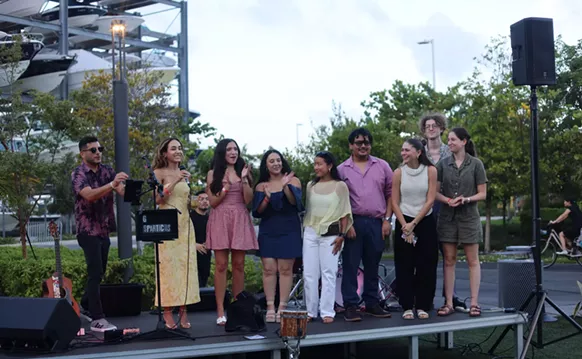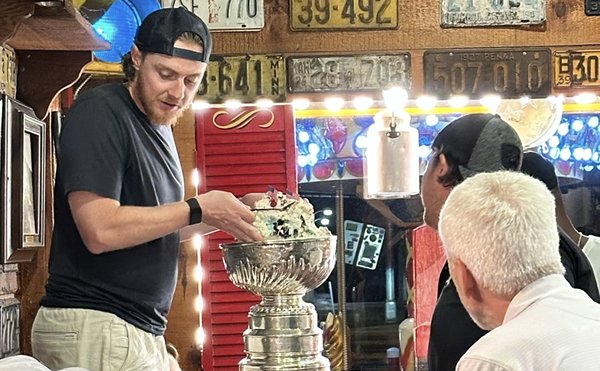On March 7, off a dirt road 40 miles west of Miami, swamp buggies careened into the thicket and little kids shimmied up a 40-foot wooden pole trying to grab the $50 bill stapled to the top. At a booth, Betty Osceola, a Miccosukee tribe member with a long black braid, sold small dolls and hand-carved tools. Her uncle, Bobby C. Billie, looked on coolly, wearing reflective sunglasses and a traditional patchwork shirt. Beside them, Frank Denninger, a 66-year-old hunter in a camouflage hat, pinched a cigarette between his fingers.
Denninger exhaled a stream of smoke and nodded his chin at Billie. “Me and him shut down two underpasses,” he brags, referring to a canceled road project. “We stopped the jetport,” he says, referring to a massive airport plan that was halted midproject.
Now, the Native Americans who live along Tamiami Trail and the outdoorsmen who play there are again teaming up, this time to fight an unlikely threat: not a massive commercial development or a land grab by politicians but a bike lane.
The proposed River of Grass Greenway (ROGG) would be a hard-surfaced path, 12 to 16 feet wide, running just alongside Tamiami Trail, 75 miles from Naples to Miami. Ninety percent of it would go through state and national parks. It would incorporate levees, boardwalks, and bridges. Parking lots, bathrooms, and access points would need to be built. The estimated cost? Between $38 million and $76 million, cobbled together from various national, state, and county agencies.
The plan is touted by bike activists and government officials as an environmentally friendly tourism boon that could single-handedly change Florida’s image as a bad place for cyclists.
“Promote a few less cars on the road and you’re winning already,” says Kevin Grimes, 29-year-old manager of Fort Lauderdale’s Two&, a bike shop and bar.
But Denninger and Osceola say the path would be doubly bad. Not only would it further threaten a damaged ecosystem with new construction, they contend, but it also would trample the rights of the people who live there. The pair are forming an unlikely coalition, with a planned march next month to draw attention to what they say is a damaging idea. “The whole thing is an abomination,” Denninger says.
There’s no question that the Everglades remain perched on a knife’s edge of survival. The entire ecosystem from Lake Okeechobee south has been destroyed since the early 1900s, when the U.S. Army Corps of Engineers began building roads and canals in an effort to turn “useless swampland” into farms and other developments. By midcentury, it became increasingly clear that the Everglades was actually a critical “River of Grass” that swept water southward, replenishing a freshwater aquifer and providing habitats for plant and animal species.
Among the biggest problems is Tamiami Trail, which was built in the 1920s to connect Miami and Naples. The project was constructed atop a levee to raise it above the water level, but scientists later realized the road acted like a dam, blocking the vital flow of water. Pollution built up in the area north of the Trail, and species on each side of the road were decimated. After two decades of debate on how to fix the problem, a one-mile section of the trail was at last raised onto a bridge in 2013, at a cost of $80 million. Another $180 million, 2.6-mile bridge section is planned.
Patty Huff, a self-described environmentalist from Naples, has been an avid cyclist since she and her husband pedaled from Florida cross-country to Oregon in 2000, when she was 54. She noted that even though fellow distance cyclists regularly plowed across the Tamiami Trail, they did so at their own great peril.
“Most of the states we have bicycled around have off-road trails and more opportunities for visitors to enjoy our national parks,” Huff says today. In Florida, cyclists regularly dodge semis with little median on the side.
Starting in 2006, Huff, along with the Naples Pathways Coalition, began pitching state and federal officials on the idea. Two years later, the National Park Service began looking at the feasibility of the project, eventually nabbing a $1 million grant for a study. A resulting draft master plan was released in December.
Despite some eye-opening financial projections — including an estimate that the trail could cost up to $1 million per mile to construct — many bike advocates are still bullish on the idea. Grimes, the Fort Lauderdale cyclist, says he believes the trailway would be popular among bikers. “Being able to ride across the state, that has a lot of appeal,” he says.
Advocates point out that Florida is woefully behind other states in creating lush greenways. A 250-mile Coast-to-Coast Connector Trail is being pieced together between St. Petersburg and Titusville, but it still has big gaps. There’s also a proposal to build a trail between Miami Beach and West Palm. But in 2014, Florida just ranked 28th on the League of American Bicyclists’ list of bike-friendly states. “Tamiami Trail is so dangerous that nobody wants to take it,” Grimes says.
For the unlikely pairing of Native American activists and outdoorsmen already lining up against the project, though, those potential benefits don’t come close to outweighing the threats.
Denninger has loved the Everglades since he was a kid in Hialeah and started traveling west to hunt deer with a gun his dad gave him. Denninger, who made a living as a machinist, has become an outspoken advocate for the culture of Gladesmen, the outdoorsmen who for generations have fished and explored in the wilderness.
Denninger points out that the master plan predicts half a million visitors per year would use the pathway, a projection that fills him with dreadful images: a crowded trail, with cruise ship passengers on shore excursions pouring into the Everglades. “That’s how you get to 2 million people,” he says.
He heard about the proposed path about three years ago but heard about a meeting only after the December plan was released. Soon, he connected with Billie, who had partnered with him in past advocacy on Everglades-threatening projects. Osceola got involved more recently, after the study came out in December and her uncle enlisted her help.
The environmental threat, they say, is obvious: Even if sections are elevated on bridges or boardwalks, building the pathway would create yet another obstacle to water flowing through the Everglades. “The estimated $76 million it would cost to build this bikeway would be better spent creating a spillway to restore the Everglades,” Osceola says.
“I’m a person; I’m not an attraction. What, we’re in a zoo now?”
tweet this
For Native Americans in the area, the plan presents another problem: It will further trample the already threatened rights of indigenous peoples, who complain they’ve largely been left out of the planning process.
By the mid-1800s, after decades of warfare with European settlers and deadly disease outbreaks, only 200 or 300 Native Americans remained in the small tree islands of the Everglades. Their descendants continue to live here today. To receive federal recognition, political power, and reservation land, some organized as the Seminole Tribe; others, as the Miccosukee Tribe. Some, like Billie, chose not to join either and still consider a treaty from the 1800s to be in effect; it grants them the rights to all of Southwest Florida.
Today many of these indigenous people live in homes along the Trail — on the Miccosukee reservation and also in dozens of unmarked villages along it. Osceola says for those residents, the pathway is “an invasion of our privacy.”
“They want to put us on display,” Osceola says. “I don’t need to be on display. I’m a person; I’m not an attraction. What, we’re in a zoo now?”
Billie and Osceola say that the master plan includes aerial photos of a site where they perform a sacred ritual, the annual corn dance. “We don’t even like those photos taken,” she says, also wary of signage marking burial mounds. “There’s a reason we don’t want you to know where it is — because it’s private.”
Some Miccosukee Tribe members are on the path-planning steering committee, though the tribe didn’t respond to a request for comment on its official position.
Huff points out that the path could be respectful to Indian rights, noting that she’d recently biked a similar trail through Native American lands in Minnesota. “There will be no interference with indigenous homes and sacred sites,” she says. “We would like to have educational information available about the culture of the Native Americans, but no one will be ‘put on display.’?”
Officials say it’s still far too early to raise protests. An updated draft master plan — with input from 14 agencies — will be revealed in April, after which a 30-day public comment period will follow. The next step would be a Department of Transportation study, then trying to piece together funding as an environmental impact study is conducted.
“It could be ten or 20 years before anything is ready,” says Mark Heinicke, a senior park planner with Miami-Dade County Parks and Recreation who is managing the project. “Bulldozers are not revving up to break ground tomorrow.”
But such dismissiveness has only made critics more suspicious. Billie wrote letters opposing the project as early as 2012, when he first heard of it, but planning has continued anyway.
That’s why he’s partnering with Denninger and Osceola to bring more attention to the complaints about the River of Grass Greenway. A Walk for Mother Earth is scheduled to begin March 28 at Trail Lakes Campground in Ochopee, near the Big Cypress Preserve. Walkers will cover 15 miles per day, following the path of the proposed trail and ending at Krome Avenue on April 2. The event includes meals and fireside chats with Billie.
Osceola says their demand is simple: shut down the bike trail idea completely before it goes any further.
Or, as Billie wrote to Huff and Hei-nicke in 2012: “We do not want to see any road building equipment or machinery, lime rock, gravel, concrete, asphalt or any other road building materials or machinery on our Aboriginal Indigenous Land. We do not want you to start or even think about it. Hang it up and forget about the Project, unless you walk barefoot in the woods — that would be healing.”
For details on the project, visit riverofgrassgreenway.org.









